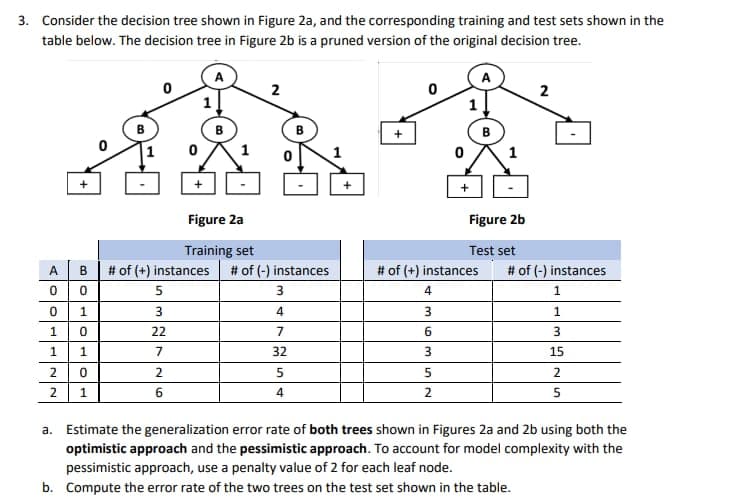3. Consider the decision tree shown in Figure 2a, and the corresponding training and test sets shown in the table below. The decision tree in Figure 2b is a pruned version of the original decision tree. 2 2 1 Figure 2a Figure 2b Training set Test set A B # of (+) instances # of (-) instances # of (+) instances # of (-) instances 3 4 1 3. 4 1 22 7 6. 3 7 32 3. 15 2. 2. 2 2. 1. 6. 4 2 5 a. Estimate the generalization error rate of both trees shown in Figures 2a and 2b using both the optimistic approach and the pessimistic approach. To account for model complexity with the pessimistic approach, use a penalty value of 2 for each leaf node. b. Compute the error rate of the two trees on the test set shown in the table, O
3. Consider the decision tree shown in Figure 2a, and the corresponding training and test sets shown in the table below. The decision tree in Figure 2b is a pruned version of the original decision tree. 2 2 1 Figure 2a Figure 2b Training set Test set A B # of (+) instances # of (-) instances # of (+) instances # of (-) instances 3 4 1 3. 4 1 22 7 6. 3 7 32 3. 15 2. 2. 2 2. 1. 6. 4 2 5 a. Estimate the generalization error rate of both trees shown in Figures 2a and 2b using both the optimistic approach and the pessimistic approach. To account for model complexity with the pessimistic approach, use a penalty value of 2 for each leaf node. b. Compute the error rate of the two trees on the test set shown in the table, O
Database System Concepts
7th Edition
ISBN:9780078022159
Author:Abraham Silberschatz Professor, Henry F. Korth, S. Sudarshan
Publisher:Abraham Silberschatz Professor, Henry F. Korth, S. Sudarshan
Chapter1: Introduction
Section: Chapter Questions
Problem 1PE
Related questions
Question

Transcribed Image Text:3. Consider the decision tree shown in Figure 2a, and the corresponding training and test sets shown in the
table below. The decision tree in Figure 2b is a pruned version of the original decision tree.
2
2
B
B
1
Figure 2a
Figure 2b
Training set
# of (+) instances # of (-) instances
Test set
# of (+) instances
# of (-) instances
A
B
4.
1
1
3
4
3
1
22
7
6.
32
3
15
2
2
2
1
6
2.
5
a. Estimate the generalization error rate of both trees shown in Figures 2a and 2b using both the
optimistic approach and the pessimistic approach. To account for model complexity with the
pessimistic approach, use a penalty value of 2 for each leaf node.
b. Compute the error rate of the two trees on the test set shown in the table.
HOHO
1.
Expert Solution
This question has been solved!
Explore an expertly crafted, step-by-step solution for a thorough understanding of key concepts.
This is a popular solution!
Trending now
This is a popular solution!
Step by step
Solved in 4 steps with 3 images

Knowledge Booster
Learn more about
Need a deep-dive on the concept behind this application? Look no further. Learn more about this topic, computer-science and related others by exploring similar questions and additional content below.Recommended textbooks for you

Database System Concepts
Computer Science
ISBN:
9780078022159
Author:
Abraham Silberschatz Professor, Henry F. Korth, S. Sudarshan
Publisher:
McGraw-Hill Education

Starting Out with Python (4th Edition)
Computer Science
ISBN:
9780134444321
Author:
Tony Gaddis
Publisher:
PEARSON

Digital Fundamentals (11th Edition)
Computer Science
ISBN:
9780132737968
Author:
Thomas L. Floyd
Publisher:
PEARSON

Database System Concepts
Computer Science
ISBN:
9780078022159
Author:
Abraham Silberschatz Professor, Henry F. Korth, S. Sudarshan
Publisher:
McGraw-Hill Education

Starting Out with Python (4th Edition)
Computer Science
ISBN:
9780134444321
Author:
Tony Gaddis
Publisher:
PEARSON

Digital Fundamentals (11th Edition)
Computer Science
ISBN:
9780132737968
Author:
Thomas L. Floyd
Publisher:
PEARSON

C How to Program (8th Edition)
Computer Science
ISBN:
9780133976892
Author:
Paul J. Deitel, Harvey Deitel
Publisher:
PEARSON

Database Systems: Design, Implementation, & Manag…
Computer Science
ISBN:
9781337627900
Author:
Carlos Coronel, Steven Morris
Publisher:
Cengage Learning

Programmable Logic Controllers
Computer Science
ISBN:
9780073373843
Author:
Frank D. Petruzella
Publisher:
McGraw-Hill Education